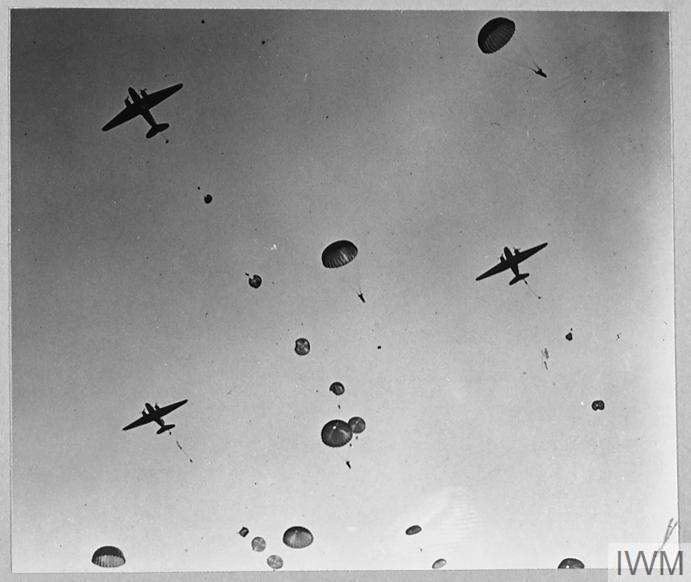British 1st Airborne Division
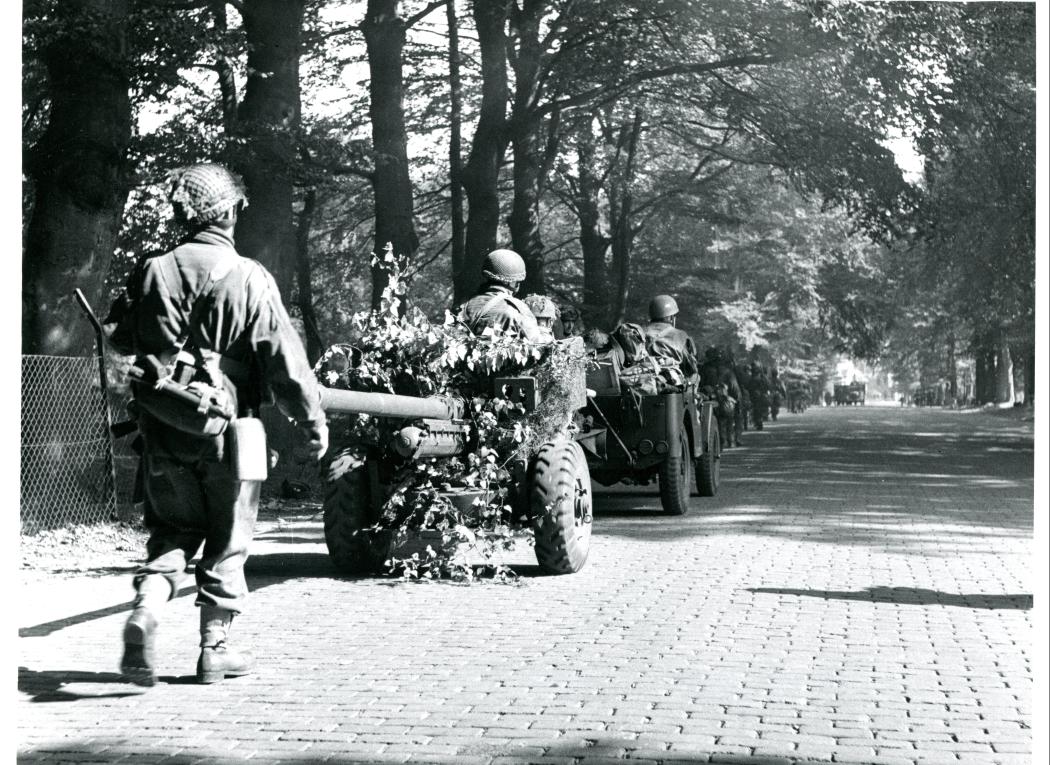
The concept of Airborne warfare took root slowly among a few nations before the World war II. It was first tested in combat by the Germans in 1940.
The British were slow to develop their own Airborne formations but eventually established two Airborne Divisions during World War II: the 1st and 6th Airborne Divisions.
The 1st Airborne Division was the British Army's trailblazer in this novel form of warfare.
MILITARY PARACHUTING BEFORE WORLD WAR II

Soviet paratroopers jump from a Tupolev bomber in the 1930s. (Public domain)
In 1918, the Americans considered dropping troops by parachute around the fortress of Metz but the war ended before this was needed. Little happened to develop the idea of inserting troops by air behind enemy lines until the 1930s, when Soviet, German, Italian, Polish and French military units were set up to test concepts and equipment. In Britain, military commanders did not embrace the concept and so, when war broke out in 1939, the British had no Airborne units or experience.
WAR COMES AGAIN
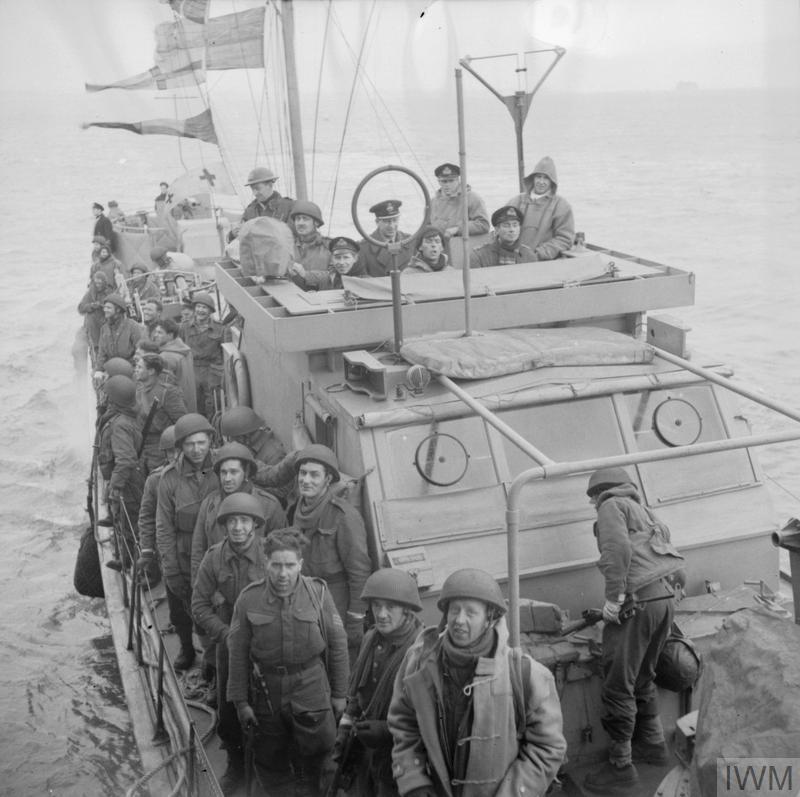
Men of 'C' Company, 2nd Parachute Battalion, arrive in Portsmouth harbour on the morning after the Bruneval raid, 28 February 1942. The Commander of the assault force, Major J D Frost, is on the bridge, second from left. Frost commanded the Battalion at Arnhem in September 1944. (IWM H 17365)
In 1940, when German victory in France seemed inevitable, the British considered less conventional ways of taking the war to the enemy. In June 1940, the first British parachute training unit was set up to train small numbers of parachute commandos for raiding and guerrilla activities behind enemy lines. Small-scale raiding operations followed over the next couple of years:
- February 1941: 38 parachute troops damaged the Tragino aqueduct in southern Italy.
- February 1942: 119 troops landed at Bruneval on the coast of northern France and captured equipment and personnel from a German cliff-top radar site.
- November 1942: two gliders containing Royal Engineers were towed to Norway to attack a German plant supplying ‘heavy water’ to the German atomic weapon programme; they crashed (as did one towing aircraft) and the mission failed.
The impetus for developing large-scale British Airborne Forces came from Prime Minister Winston Churchill, who had been impressed by the German use of parachute and glider troops in their invasions of Norway, Denmark, Netherlands and Belgium in April/May 1940. In June 1940, Churchill declared:
We ought to have a corps of at least 5,000 parachute troops, including a proportion of Australians, New Zealanders and Canadians, together with some trustworthy people from Norway and France. 1
Britain’s Airborne forces were gradually enlarged. In September 1941, the 1st Parachute Brigade was formed, followed by the 1st Airlanding Brigade (glider troops) in October 1941. To coordinate the growing development and training of Airborne forces, and to command them, Headquarters 1st Airborne Division was formed in November 1941. Over the next few months, the Glider Pilot Regiment and Parachute Regiment were formed, the latter bringing together all troops who had already volunteered for parachute infantry duties but were on detachment from their parent regiments. In July 1942, the 2nd Parachute Brigade was formed but the Division was still not at its full war strength by the end of 1942, despite the progress made towards it.
- 1
Greenacre, Dr John W. Churchill’s Spearhead: The Development of Britain’s Airborne Forces during the Second World War (Kindle Locations 443-445), Pen & Sword Aviation.
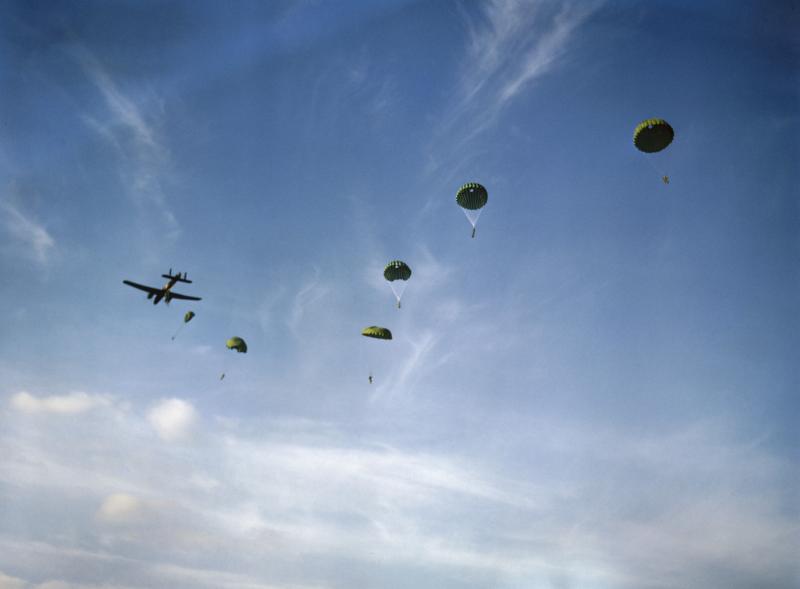
Paratroopers dropping from an Armstrong Whitworth Whitley of No 295 Squadron at Netheravon, October 1942. (Official photographer, public domain, via Wikimedia Commons)
As well as the Army’s need to create new procedures for this novel type of warfare, the RAF also had to develop its structure, equipment and procedures to support the growing Airborne forces. In January 1942, the RAF formed No 38 Wing (later No 38 Group) as its specialized organization to support Airborne operations. There were difficulties between the RAF and the Army over the priorities for the use of aircraft and these affected the speed of the development of 1st Airborne Division and the future of British Airborne forces. These difficulties were eventually overcome, and the scale of Britain’s Airborne forces by the war’s end was a significant achievement: a British airborne corps of two complete divisions, one independent parachute brigade group and a special air service brigade, with one Polish Independent Parachute Brigade group and units of parachutists from Belgium, France, Holland and Norway. 2
- 2
Otway, Lt Col Terence BH, DSO, Airborne Forces of the Second World War 1939-45, Official History of the Second World War – Army, Naval & Military Press Ltd, 4.
NORTH AFRICA
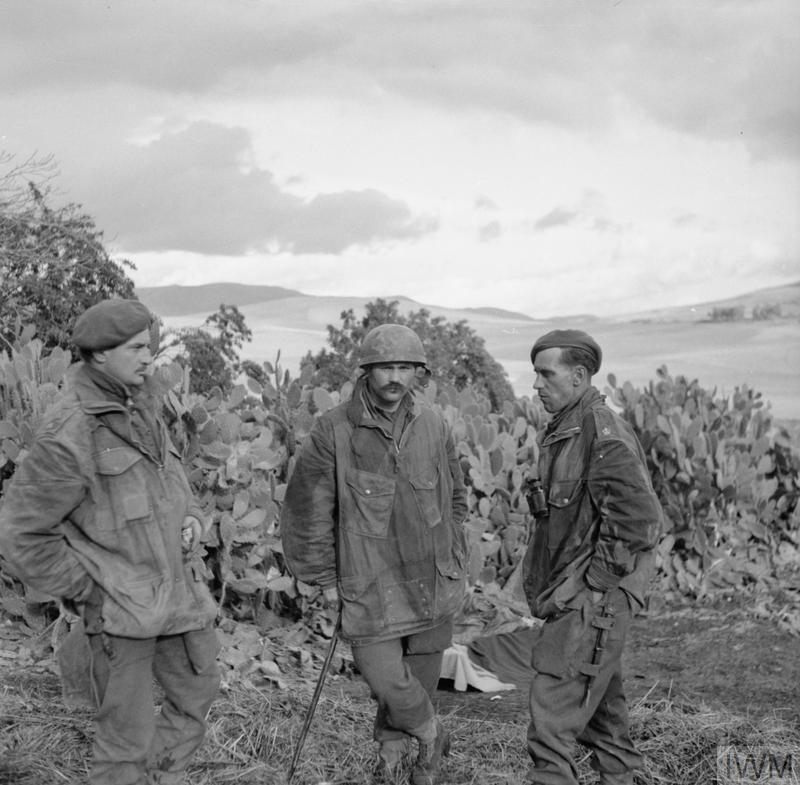
Officers of the 2nd Battalion, Parachute Regiment resting near Beja after returning from a drop on Depienne Airfield, 26 December 1942. (IWM NA 351)
In November 1942, 1st Parachute Brigade was deployed independently to North Africa as part of the Allied forces engaged in Operation TORCH. It fought hard in Tunisia until enemy resistance in North Africa ceased in May 1943, undertaking three parachute drops and operating as elite infantry alongside non-Airborne units. The paratroops’ toughness in combat, together with the appearance of the ‘tail’ of their Airborne smocks caked in red earth, earned them the nickname ‘Red Devils’ from the Germans. By June 1943, the whole of 1st Airborne Division – comprising the 1st, 2nd and 4th Parachute Brigades, 1st Airlanding Brigade and supporting units - was in North Africa and had begun preparing for the invasion of Sicily.
SICILY
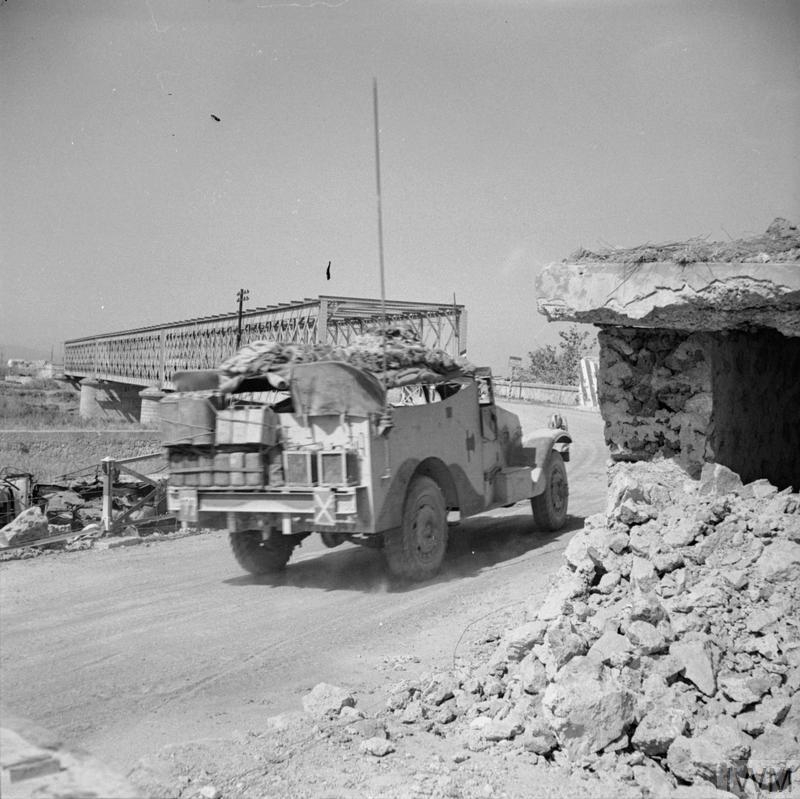
British troops advance across Primosole Bridge after it had finally been captured. (IWM NA 5281)
The British 1st Airborne and US 82nd Airborne Divisions would land in Sicily to secure vital bridges and high ground inland of the seaborne assault forces.
On the night of 9/10 July 1943, 1st Air Landing Brigade’s 2,000 soldiers were towed in over 144 gliders by 109 American C-47 Dakotas and 35 RAF tugs. 3 A variety of problems, including inexperienced American aircrew, poor weather, enemy and ‘friendly’ fire, resulted in significant Airborne casualties. Many of the gliders were cast off too soon, with 78 landing in the sea and 252 soldiers drowning. Despite being understrength, the glider troops captured the Ponte Grande bridge but were pushed off the following day before British seaborne troops arrived and recaptured it.
During the night of 13 July 1943, the 1st Parachute Brigade dropped in Sicily to capture the Primosole Bridge over the River Simeto. Their aircraft were fired upon by both the enemy and the Allied invasion fleet, and the drop was widely scattered but the bridge was captured by dawn on 14 July. The Germans counter-attacked and re-took the bridge but it fell to the British again on 15 July when troops from the seaborne landing arrived. The 1st Airborne Division was then withdrawn into reserve in North Africa; it had suffered 454 killed, 240 wounded and 102 missing in Sicily. 4
On 9 September 1943, 1st Airborne Division landed by ship in Taranto harbour in southern Italy. It then fought as light infantry with the Allied forces clawing their way northwards from Italy’s south coast.
In November 1943, 1st Airborne Division returned to the UK to prepare for the invasion of north-west Europe, taking up home at bases in the East Midlands.
PREPARING TO LIBERATE WESTERN EUROPE
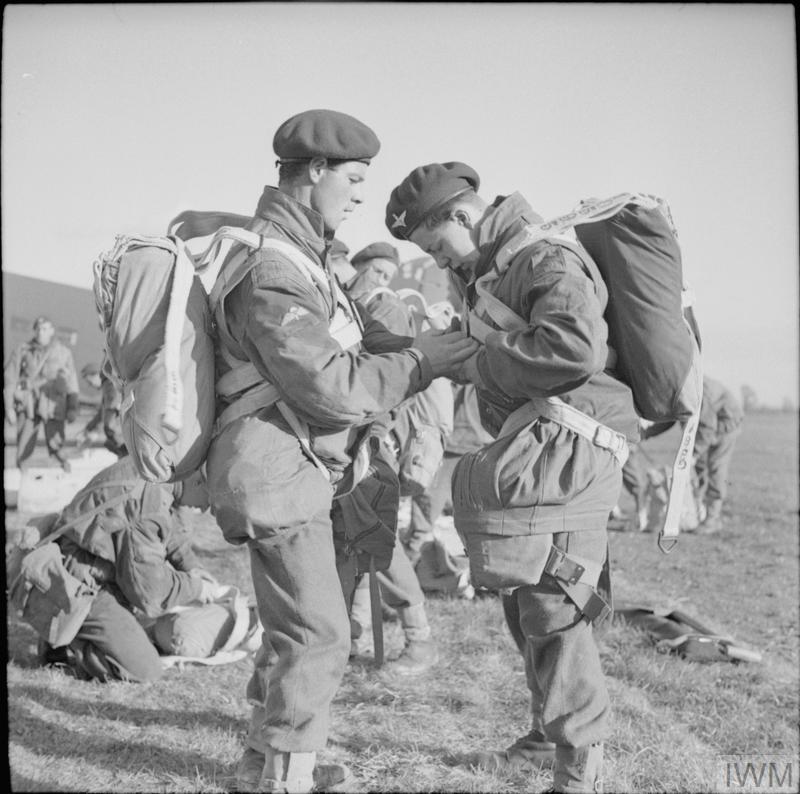
Paratroopers adjust their parachute harnesses during Exercise MUSH on 22 April 1944. (IWM H 37730)
After a period of recuperation, the Division’s personnel resumed training to ensure their delivery by parachute or glider was second nature, their tactical and weapon skills were instinctive, and their physical fitness was supreme. The main training window would last until the Allied assault on mainland Europe in June 1944, after which the Division would be on stand-by as a reserve force for immediate deployment.
Men of the 1st and 4th Parachute Brigades were sent for refresher parachute training at Stoney Cross airfield in Hampshire and No 1 Parachute Training School at Ringway (now Manchester Airport). This was particularly important for the 4th Parachute Brigade, whose personnel had undertaken initial parachute training in India and the Middle East, where the latest training techniques, equipment and aircraft were not available. Continuation training was carried out from local East Midlands airfields using US C-47 troop carrier aircraft.
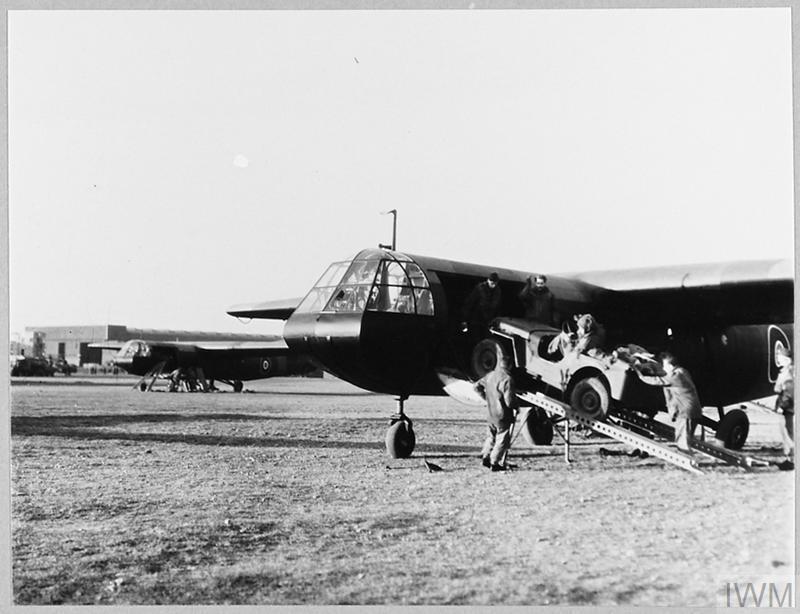
Unloading a jeep from a Horsa glider. (IWM CH 13203)
Men of the 1st Airlanding Brigade took part in glider training exercises, and these were not without losses: on 4-5 April 1944, 33 men died when a Horsa glider and its tug crashed in Hampshire during bad weather.
Tactical drills were practised at various unit levels, and included such techniques as general battle drills, street-fighting, reorganization after night landings, night attacks, and setting up defensive positions.
Infantry platoons (around 35 men) and companies (around 120 men) ran their own training programmes for individual weapon handling, camouflage and concealment, fire and manoeuvre, and physical fitness. Long-distance route marches with combat equipment were a favoured training aid because they improved strength, endurance and speed in one exercise.
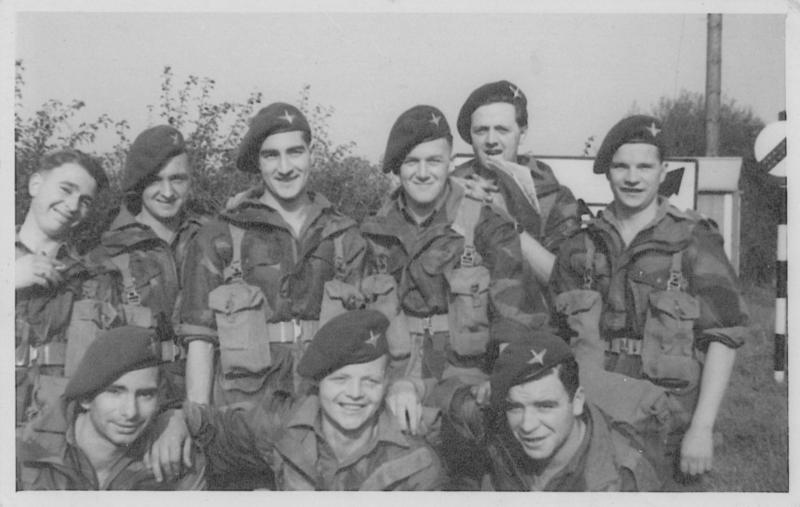
Men of 3 Platoon, 'A' Company, 2nd Parachute Battalion, on a route march near Grantham, just before Operation MARKET GARDEN. (Via Bob Hilton)
There were also Brigade-level exercises (2,000-2,500 men) and one major formal exercise for the whole Division (around 12,100 men) in May 1944 - Exercise RAGS – which took place in East and North Yorkshire.
In addition to training involving physical activities, troops also attended talks on such topics as the course of the war, escape and evasion, and the latest German organization and tactics. For familiarization purposes, exchanges visits were organized between units of the 1st Airborne Division, US 82nd Airborne Division and US IX Troop Carrier Command.
OPERATION MARKET GARDEN
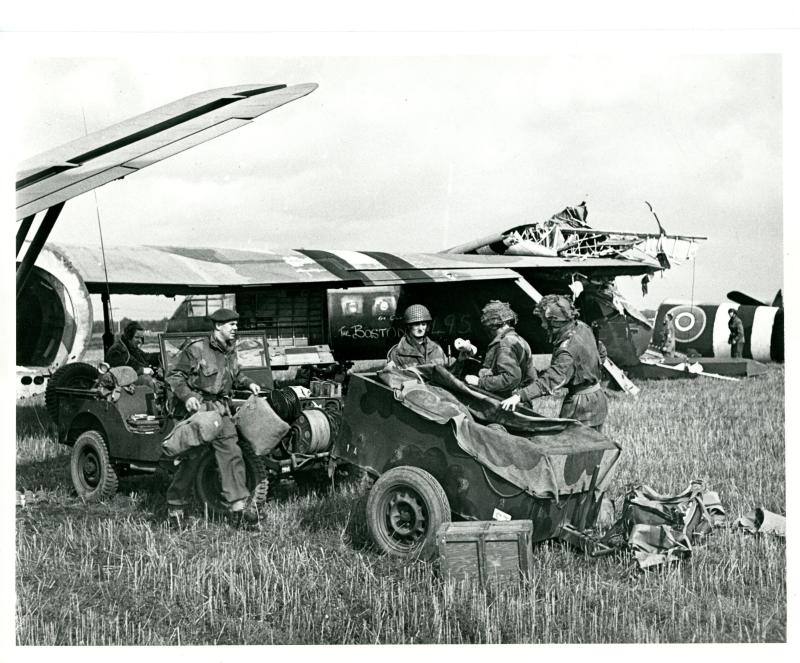
17 September 1944, Landing Zone Z, west of Arnhem. Unloading a Horsa glider that brought in the Royal Artillery’s Regimental Headquarters. (Paradata/Airborne Assault Museum)
When the Allies landed in Normandy in June 1944, the British 6th Airborne Division - sister unit to 1st Airborne Division - dropped into Normandy on D-Day to help secure the eastern flanks of the landing beaches. The 1st Airborne Division did not take part in the D-Day assault but was held in high-readiness reserve to reinforce or exploit ground situations as necessary. In August 1944, the 1st Polish Independent Parachute Brigade was placed under the command of the British 1st Airborne Division.
After a slow start, Allied troops advanced rapidly through France and Belgium and 16 operations involving 1st Airborne Division were planned and cancelled because the Allies had captured the ground involved. Finally, on 17 September 1944, the 1st Airborne Division – together with the US 82nd and 101st Airborne Divisions – were launched into Operation MARKET GARDEN around Arnhem, Nijmegen and Eindhoven to capture and hold key river bridges while Allied ground forces advanced to meet them.

17 September 1944: C-47 aircraft of the US 314th Troop Carrier Group flying from Saltby drop British paratroopers of the 3rd Parachute Battalion on Drop Zone X, west of Arnhem. (Paradata/Airborne Assault Museum)
Apart from 186 Pathfinders who flew from Fairford in Gloucestershire on the first day, all the parachute troops of the 1st Airborne Division flew to Arnhem in American C-47 aircraft from Barkston Heath, Saltby and Spanhoe airfields.
Although the American objectives around Nijmegen and Eindhoven were captured and held, the road bridge over the Neder Rijn river at Arnhem proved ‘a bridge too far’. Units of 1st Airborne Division captured the bridge and held it beyond the two days planned, but they and their colleagues fighting in the western suburbs of Arnhem were eventually overwhelmed by German forces. A total of 11,920 men of the 1st Airborne Division, 1st Polish Independent Parachute Brigade and attached elements took part in the Arnhem operation; of those, 3,910 managed to escape across the Neder Rijn river after the battle ended. 5
- 5
Barry Gregory, British Airborne Troops, 1940-45 (London, 1974), 92.
OPERATION DOOMSDAY

The Airborne troops proved very popular with the Norwegian civilians. Here, a member of the 2nd Battalion, South Staffordshire Regiment, happily gives his autograph to a young Norwegian lady. (Paradata/Airborne Assault Museum)
The 1st Airborne Division was decimated at Arnhem. After it returned to its bases in the East Midlands, replacements gradually filtered into its component units, many of which only existed in name. The 4th Parachute Brigade was destroyed at Arnhem and was not re-built. The Division was not fit to mount another Airborne operation before the war’s end in May 1945, but it was used in one final operation: Operation DOOMSDAY.
The surrender of all German forces in Europe took effect on 8 May 1945. Allied troops needed to oversee and disarm the surrendering Germans, and it was decided that 1st Airborne Division would be sent to Norway to carry out those tasks. Its 1st Parachute Brigade was first detached and sent to Denmark on Operation ECLIPSE and the Special Air Service Brigade was temporarily attached to the Division as a replacement. The Division received a rapturous welcome from the Norwegians, as it helped recover Allied prisoners of war, arrested war criminals, allocated German units to specific areas and oversaw their disarming of minefields. In June 1945, it conducted the welcoming ceremony for the return of the King of Norway from exile.
The 1st Airborne Division and the SAS Brigade returned to England at the end of August 1945 and went on much-deserved leave. Planners had already been considering the size of Army that the UK would need in the post-war world. They decided that the nation would need a much smaller Army and that there would be a need for only one Airborne Division and no need for the SAS. The SAS would therefore be disbanded and so would one Airborne Division – but which one? Given the amount of time that it would have taken to bring the 1st Airborne Division up to fully trained strength, it was decided to retain the fully trained 6th Airborne Division and disband the 1st Airborne Division.
During the last two months of its existence, the 1st Airborne Division prepared trainees for the 6th Airborne Division and undertook the administrative actions required before its formal disbandment. On 15 November 1945, the 1st Airborne Division was disbanded, passing proudly into the history of the British Army. 6
- 6
Terence B H Otway, Airborne Forces of the Second World War, 1939-45, Facsimile of War Office publication of 1951 (Uckfield, 2019), 324–29.
CLICK FOR MORE INFORMATION
Jewish Refugees serving as 1st Airborne Division Pathfinders
British African-Caribbean Airborne Soldiers
Airborne Spies: 89 Field Security Section, Intelligence Corps
The King's Visit to the British 1st Airborne Division, 16 March 1944
1st Airborne Division Headquarters Defence Platoon
US Airborne Forces in the East Midlands, 1943-45
Extensive information on the history of the Parachute Regiment and Airborne Forces can be found at Paradata, the official digital archive of the Parachute Regiment and Airborne Forces (Paradata), and at Pegasus Archive (Pegasus Archive).
If you have any information that you would like to share with Paradata and the Pegasus Archive, or have any queries about the history of British Airborne Forces, please contact them by clicking on these links:
BIBLIOGRAPHY
Barrymore Halpenny, Bruce, Action Stations 2: Military Airfields of Lincolnshire and the East Midlands (Wellingborough, 1981)
Beevor, Antony, Arnhem - the Battle for the Bridges, 1944 (London, 2019)
———, ‘Order of Battle: Operation Market Garden’, Antony Beevor, Historian <https://www.antonybeevor.com/order-of-battle-operation-market-garden/>
Buckingham, William F, Arnhem 1944 (Stroud, Gloucestershire, 2004)
Chant, Chris, Airborne Operations, ed. by Philip de Ste Croix, Paperback (London, 1982)
Cholewczynski, George F, Poles Apart (London, 1993)
Dear, Ian, and M R D Foot, The Oxford Companion to the Second World War (Oxford, 1995)
Delve, Ken, Military Airfields of Britain (Ramsbury, 2008)
Eisenhower, Dwight D, Eisenhower’s Own Story of the War the Complete Report by the Supreme Commander General Dwight D. Eisenhower on the War in Europe from the Day of Invasion to the Day of Victory, E-Book published 2019 (1946)
Freeman, Roger A, UK Airfields of the Ninth Then and Now (1994)
Frost, John, A Drop Too Many, Kindle Edition (Barnsley, 2009)
Fullick, Roy, Shan Hackett - the Pursuit of Exactitude, Kindle Edition (Barnsley, 2003)
Greenacre, John, Churchill’s Spearhead (Barnsley, 2010)
Gregory, Barry, British Airborne Troops, 1940-45 (London, 1974)
Gregory, Barry, and John Batchelor, Airborne Warfare 1918-1945 (London, 1979)
Hamlin, John F, Support and Strike! A Concise History of the US Ninth Air Force in Europe (Peterborough, 1991)
Hickman, Mark, ‘The Battle of Arnhem Archive’, Www.pegasusarchive.org, 2000 <https://www.pegasusarchive.org/arnhem/frames.htm> [accessed 2024]
Jackson, Robert, Arnhem - the Battle Remembered (Shrewsbury, 1994)
Kent, Ron, First in - the Airborne Pathfinders, 2nd edn (Barnsley, 2015)
Kershaw, Robert J, A Street in Arnhem, Paperback (Addlestone, 2015)
———, It Never Snows in September (New York, 1999)
Magreehan, Mark, Britain’s Airborne Forces of WWII, Kindle edition (2021)
Margry, Karel, Market Garden Then and Now Boxed Set (2002)
Marix Evans, Martin, Wybo Boersma, and Adrian Groeneweg, The Battle of Arnhem (Andover, 1998)
Mead, Richard, General ‘Boy’ - the Life of General Sir Frederick Browning GCVO, KBE, CB, DSO, DL , Kindle Edition (Barnsley, 2010)
Middlebrook, Martin, Arnhem 1944 (London, 1994)
Montgomery, Bernard Law, The Memoirs of Field Marshal Montgomery, Kindle Edition (Barnsley, 2005)
Newell, Grant R, Airborne to Arnhem, Volume 1 (Warwick, 2023)
O’Reilly, John, 156 Parachute Battalion from Delhi to Arnhem (Thoroton, 2009)
Otway, Terence B H , Airborne Forces of the Second World War, 1939-45, Facsimile of War Office publication of 1951 (Uckfield, 2019)
Paradata, ‘A Living History of the Parachute Regiment and Airborne Forces’, Paradata.org.uk <https://www.paradata.org.uk/> [accessed 2024]
Ryan, Cornelius, A Bridge Too Far, 3rd edn (London, 1978)
Saunders, Tim, The Island - Nijmegen to Arnhem (Barnsley, 2008)
Sosabowski, Stanislaw, Freely I Served, Kindle Edition (Barnsley, 2013)
St George Saunders, Hilary, The Red Beret, New English Library/Times Mirror (London, 1978)
Urquhart, R E, Arnhem (Barnsley, 2008)
Vlahos, Mark C, Men Will Come, Second Edition (Hoosick Falls, NY, 2021)
Warren, John, Airborne Operations in World War II, European Theater, Defense Technical Information Center (1956)<https://apps.dtic.mil/sti/tr/pdf/ADA438105.pdf> [accessed 8 December 2024]
Weeks, John, Airborne Equipment (Newton Abbot, 1976)
———, Assault from the Sky (Newton Abbot, 1988)
